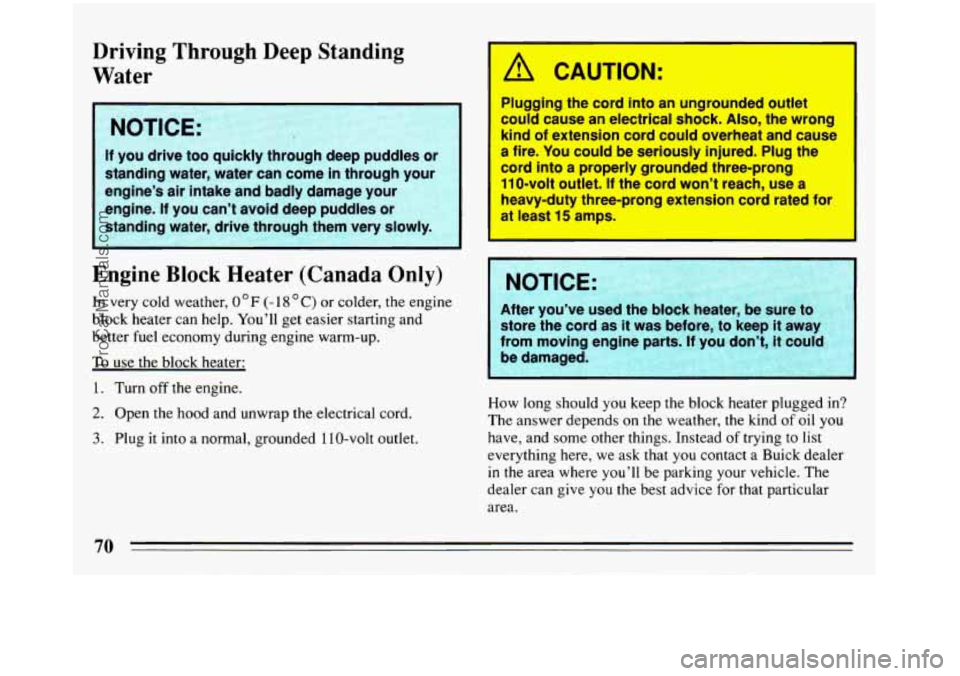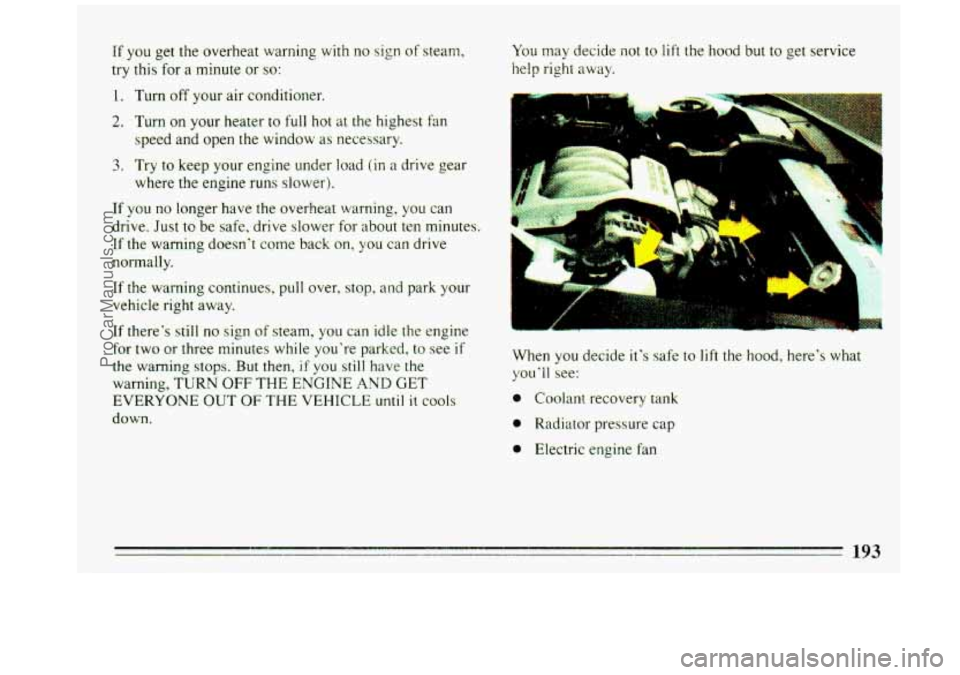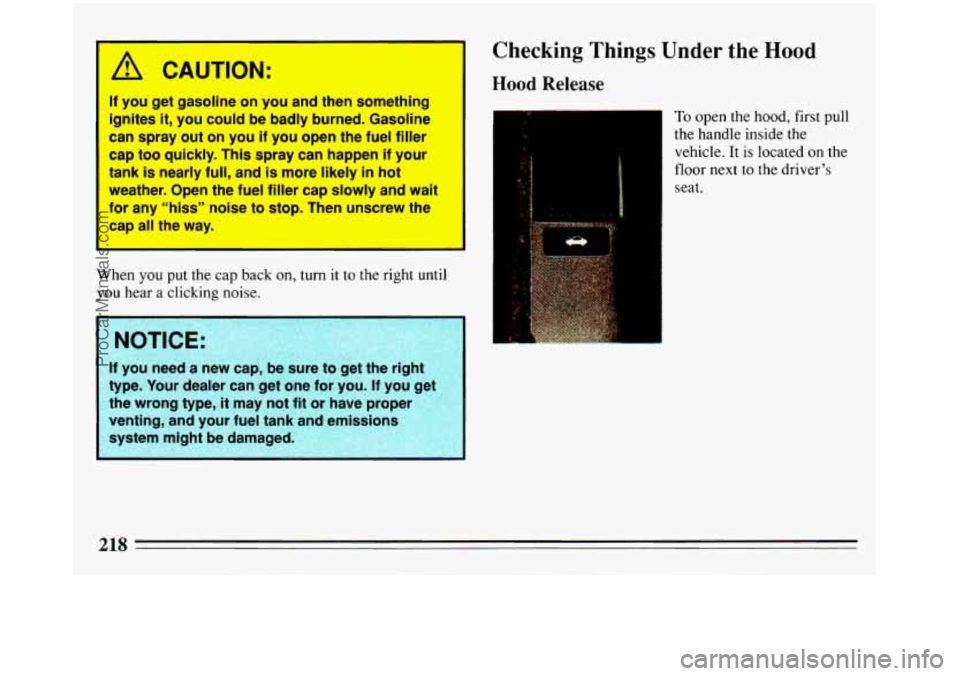1993 BUICK REGAL hood open
[x] Cancel search: hood openPage 72 of 308

Driving Through Deep Standing
Water
If you drive too quickly through deep puddles or
standing water, water can come in through your
engine’s
air intake and badly damage your
engine. If you can’t avoid deep puddles or
standing water, drive through them very slowly.
Engine Block Heater (Canada Only)
In very cold weather, 0 F (- 18 C) or colder, the engine
block heater can help. You’ll get easier starting and
better
fuel economy during engine warm-up.
To use the block heater:
1. Turn off the engine.
2. Open the hood and unwrap the electrical cord.
3. Plug it into a normal, grounded 110-volt outlet.
I
Plugging the cord into an ungrounded outlet
could cause an electrical shock.
Also, the wrong
kind of extension cord could overheat and cause
a fire. You could be seriously injured. Plug the
cord into
a properly grounded three-prong
IlO-volt outlet.
If the cord won’t reach, use a
heavy-duty three-prong extension cord rated for
at least
15 amps.
I
I
x; NOTICE:
k After you’ve used the block heater, be sure to
:; store the cord as it was before, to keep it away
i from moving engine parts. If you don’t, it could
:: be damaged. .’, :.,* :>”!;.:,.”~ i” < .:-;:.&,a2% && ?3$?%7 -
How long should you keep the block heater plugged in?
The answer depends
on the weather, the kind of oil you
have, and some other things. Instead
of trying to list
everything here, we ask that you contact a Buick dealer
in the area where you’ll be parking your vehicle. The
dealer can give
you the best advice for that particular
area.
70
ProCarManuals.com
Page 183 of 308

1 CAUTION:
You could be injured if the vehicles roll. Set the
parking brake firmly on each vehicle. Put an
automatic transaxle
in “P” (Park) or a manual
transaxle
in “N” (Neutral).
3. Turn off the ignition on both vehicles. Turn off all
lights that aren’t needed, and radios. This will avoid
sparks and help save both batteries. And it could
save your radio!
4. Open the hoods and locate the batteries.
I
I A CAUTION:
An electric fan can start up even wheVv the engine
is not running and can injure you. Keep hands,
clothing and
tools away from any underhooc‘
electric
fan.
Find the positive (+) and negative (-) terminals on
each battery.
Your Buick has a remote positive (+)jump starting
terminal. The terminal is on the same side
of the
engine compartment as your battery.
You should always use the remote positive (+)
terminal instead of the positive (+) terminal on your
battery.
To uncover the remote positive (+) terminal, lift the
red plastic cap.
181
ProCarManuals.com
Page 194 of 308

Engine Overheating
You will find a coolant temperature gage on your
Buick's instrument panel.
You may also find a low coolant warning light
on your
Buick instrument panel.
If Steam Is Coming From Your Engine:
A CAUTION:
Steam from an overheated engine can burn you
badly, even
if you just open the hood. Stay away
from the engine
if you see or hear steam coming
from it. Just turn
it off and get everyone away
from the vehicle until it cools down. Wait
until
there is no sign of steam or coolant before
opening the hood.
'* -7ou keep driving when your engine is
overheated, the liquids
in it can catch fire. You or
others could be badly burned. Stop your engine
if it overheats, and get out of the vehicle until the
engine is cool.
If your engine catch
driving with
no coolant, your vehicle can be
badly damaged. The costly repairs
w?uld not b
covered by your warranty. ,, , 1 ,.
I If No Steam Is Coming From Your Engine:
If you get the overheat warning but see or hear no
steam,
the problem may not be too serious. Sometimes
the engine can get a little too hot when you:
0 Climb a long hill on a hot day.
0 Stop after high speed driving.
0 Idle for long periods in traffic.
Tow a trailer.
ProCarManuals.com
Page 195 of 308

If you get the overheat warning with no sign of steam,
try this for
a minute or so:
1.
2.
3.
Turn off your air conditioner.
Turn on
your heater to full hot
speed and open the window as
Try to keep your engine under
where the engine runs slower). at
the highest fan
necessary.
load (in a drive gear
If you no longer have the overheat warning,
you can
drive. Just to be safe, drive slower
for about ten minutes.
If the warning doesn‘t corne back on, you can drive
normally.
If the warning continues, pull over, stop, and park
your
vehicle right away.
If there’s still
no sign of steam, you can idle the engine
for two
or three minutes while you’re parked, to see if
the warning stops. But then, if you still have the
warning,
TURN OFF THE ENGINE AND GET
EVERYONE
OUT OF THE VEHICLE until it cools
down.
You may decide not to lift the hood but to get service
help right
away.
m .... ... ..
h 1
When you decide it’s safe to lift the hood, here’s what
you’ll
see:
0 Coolant recovery tank
0 Radiator pressure cap
0 Electric engine fan
ProCarManuals.com
Page 220 of 308

A CAUTION:
If you get gasoline on you and then something
ignites it, you could be badly burned. Gasoline
can spray out on you if you open the fuel filler
cap too quickly, This spray can happen if your
tank is nearly full, and: is more likely in hot
weather. Open the fuel filler cap slowly and wait
for any “hiss” noise to stop. Then unscrew the
cap all the way.
When you put the cap back on, turn it to the right until
you hear a clicking noise.
If you need a new cap, be sure to get the right
type. Your dealer can get one for you.
If you get
the wrong type, it may not fit
or have proper
venting, and your fuel tank and emissions system might be damaged.
Checking Things Under the Hood
Hood Release
To open the hood, first pull
the handle inside the
vehicle. It is located on the
floor next to the driver’s
seat.
218
.-
ProCarManuals.com
Page 300 of 308

Heater. Engine Block .......................... 70. 224
“Highway Hypnosis”
............................. 160
Hill and Mountain Roads
.......................... 16 1
Hills. Parking on ................................ 163
Hitches. Trailer
.................................. 172
Holding a Baby
in .Your Car ......................... 4 1
Hood. Opening the ............................... 21 8
Horn
........................................... 80
Hot Coolant Warning Gage
........................ 103
Hot Engine. Safety Warnings About
................. 193
Hydroplaning
................................... 153
High
Speed. Shifting When Your Engine is Running at
... 72
Ice. Driving on
................................. 167
Identification Label. Service Parts
................... 256
Identification Number. Vehicle ..................... 256
Idling Your Engine
................................ 78
If You’re Stuck: In Sand. Mud. Ice
or Snow ........... 21 1
Ignition Key Positions ............................. 66
Indicator. Turn Signal ............................. 81
Indicators. Disc Brake Wear
....................... 142
Indicators. Warning Lights and Gages
................ 100
Infant Restraint
................................... 42
Inflation. Tire
................................... 241
Inside Mirror
.................................... 94
Inspection. Tire
................................. 242
Instrument Panel
................................. 99
Interior Cleaning ................................ 248
Introduction. How to Use this Manual
................. 10
..................................... J ack. Tire 202
Jacking Up the Car
............................... 202
“Jump” Starting
................................. 180
Keys
.......................................... 58
Keyless Entry System. Remote
...................... 62
Kilometer Indicator
............................... 99
Label. Service Parts Identification
.................. 256
Lane Change Indicator
............................. 81
LapBelt
........................................ 35
Lap-Shoulder Belt Usage by Children
................. 54
Latches. Front Seatback
............................ 18
Leathercleaning
................................ 250
Leaving Your Vehicle .............................. 77
Light. Safety Belt
................................. 25
Light. Turn Sigllal Indicator
......................... 81
Lighter. Cigarette
................................. 97
Lights Light Bulbs. Replaceable
.......................... 262
Daytime Running
.............................. 92
Fog
......................................... 92
Gages and Warning Indicators
................... 100
“On” Warning ................................ 100
Operation .................................... 91
Reading
...................................... 93
Traffic
...................................... 133
Loading
Your Vehicle ............................ 238
298
ProCarManuals.com